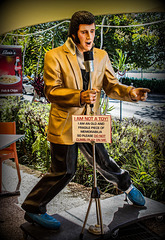
Noosa in Queensland, Australia
Folder: Australia
239/365 orange at the river
Morris
264/365 Morning coffee
Jazzy reflections
Sunlight and Shades
| |
|
Enjoying the Sunset at Noosa Surf Club, Queensland.
The Noosa Heads Surf Life Saving Club is located in the protected eastern corner of beautiful Laguna Bay on Queensland's Sunshine Coast. It commands views of Noosa National Park and Noosa main beach and is central to Noosa's accommodation and the famous Hastings Street restaurant precinct.
Tommy Bahamas
| |
|
|
|
Hastings Street, Noosa, Queensland
TSC Hats
ps There is an update on Penny and Percy Possum in the first comment :-)
Ford T Bucket Replica
| |
|
|
|
Noosa, Queensland
Built in 1983
This entry for TSC 4 Wheel vehicle replaces my first, the Bobcat S130, which technically didn't meet the brief :-)
Fruits of Noosa
#32 Hartley TS 14
Miss Tewantin
| |
|
Our traditional New Year’s Day trip on the Noosa Ferry “Miss Tewantin” from Tewantin to Noosa Heads in Queensland.
In the Light
| |
|
|
|
This was taken just after a spell of heavy rainfall and this Rainbow Lorikeet's plumage was a little wet. Larger view in the note on this image.
Hilton Esplanade, Noosa River, Queensland
These aptly named beautiful Australian birds, the Rainbow Lorikeets, parrots, have incredibly brightly coloured feathers, and a distinctive screeching call.
In Noosa they fly between the Noosa River and the Hinterland feeding on the rich variety of flowering/fruiting trees and shrubs.
Archive Airings AA51 Just One.
Pale Blue
| |
|
|
|
March scenes for 365 Days in Colour - theme Pale Blue.
Noosa River.
Noosa Boardwalk.
Wreck of SS Dicky at Caloundra.
Noosa Surf Festival.
TSC road to rock 'n' roll
| |
|
|
|
On the road to rock 'n' roll
There's a lot of wreckage in the ravine
Some you recognise
Used to hang out on the scene
On the road to rock 'n' roll
metrolyrics.com/the-road-to-rock-roll-lyrics-joe-strummer-and-the-mescaleros
www.youtube.com/watch?v=AxYqwNZSnbA
TSC Illustrate a song with "road" in the title.
Reworked unpublished 2013 photo of Elvis in a cafe on Gympie Terrace. "Offshore Noosa offers guests a unique choice of quality four and a half star accommodation in a quiet, secluded environment of lush tropical gardens right on the beautiful Noosa River. (lookout for Elvis downstairs). Situated directly opposite Pelican Beach and the Noosa Ferry Jetty"
Orange and Black
| |
|
|
|
Sunsets and Sunrises from my archives for Colour of the Month August 2016
Sunsets at Noosa Yacht Club and Hamilton Island Yacht Club
Sunrises in the Noosa Hinterland
Blue faced Honeyeater
| |
|
|
|
Seen from our verandah on the fruiting branch of a Golden Cane Palm. I have tried many times to photograph these amazing birds properly, but they were too quick for me. Lucky day.
The Blue-faced Honeyeater is a large black, white and golden olive-green honeyeater with striking blue skin around the yellow to white eye. The crown, face and neck are black, with a narrow white band across the back of the neck. The upperparts and wings are a golden olive green, and the underparts are white, with a grey-black throat and upper breast. The blue facial skin is two-toned, with the lower half a brilliant cobalt blue. Juvenile birds are similar to the adults but the facial skin is yellow-green and the bib is a lighter grey. This honeyeater is noisy and gregarious, and is usually seen in pairs or small flocks. It is known as the Banana-bird in tropical areas, for its habit of feeding on banana fruit and flowers.
birdsinbackyards.net/species/Entomyzon-cyanotis
White in April, 27/30 April, 365 Colours.
Spring Cluster
Down on the Farm
| |
|
|
|
Distant cows in a wide green paddock off of Sunrise Road in the Noosa Hinterland.
218/365
Archive Airings AA67 Waterless landscapes
Contortionist
| |
|
|
|
The Australian Pelican (Pelecanus conspicillatus) is a large black and white bird (1.6 to 1.8 metres long, wingspan 2.3 to 2.5 metres) with long bill and large throat pouch. Eye black with yellow ring. Legs and webbed feet are grey. Females similar to males with a shorter bill. Breeding birds have a yellow patch on the breast and a deep pink bill. There are no geographical variations. Wild pelicans live between 10 and possibly 25 plus years.
They normally walk and swim with head and neck extended; in flight the head is tucked back and when stalking fish the bird swims with the head held low, presumably to make harder to see from underwater.
Pelicans weigh 3 to 14 kilograms; they have an extremely light skeleton making up only ten per cent of the body weight. All pelicans have a layer of bubbles under most of their torso, believed to be for flotation and insulation.
Pelicans mainly eat fish but will also eat crustaceans, tadpoles and turtles. During periods of starvation pelicans have been reported to eat seagulls; the gull is held underwater until it drowns then is swallowed headfirst. Pelicans also rob other birds of their prey; they willingly accept handouts from humans and often cluster around fish-cleaning stations expecting fisherpeople to throw them unwanted fish scraps. Given a chance they will take bait from unguarded bait-buckets.
Jump to top
RSS feed- Latest items - Subscribe to the latest items added to this album
- ipernity © 2007-2024
- Help & Contact
|
Club news
|
About ipernity
|
History |
ipernity Club & Prices |
Guide of good conduct
Donate | Group guidelines | Privacy policy | Terms of use | Statutes | In memoria -
Facebook
Twitter


















